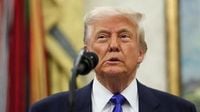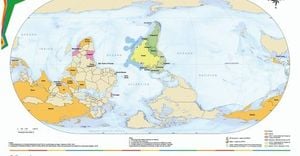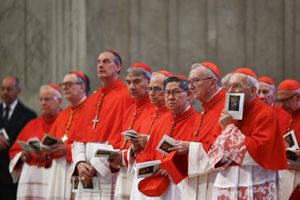In a move that could escalate tensions in the Middle East, U.S. President Donald Trump is reportedly set to announce that the United States will officially adopt the term "Arabian Gulf" in place of the historically recognized "Persian Gulf" during his upcoming visit to the region. This decision has already drawn sharp criticism from Iranian officials, who view the name change as an affront to their national identity.
According to a report by the Associated Press on May 7, 2025, two U.S. officials confirmed that Trump plans to make this announcement during his trip. The renaming of the strategic waterway has long been a contentious issue, particularly for Iran, which staunchly defends the term "Persian Gulf" as a part of its historical and cultural heritage.
Iranian Foreign Minister Abbas Araghchi expressed outrage over the reported decision, stating, "Politically motivated attempts to alter the historically established name of the Persian Gulf are indicative of hostile intent toward Iran and its people, and are firmly condemned." He further emphasized that such actions would provoke the ire of Iranians globally, asserting that any attempt to change the name would lack validity and legal effect.
This is not the first time Trump has stirred controversy regarding the term. In 2017, during his first term, he referred to the body of water as the "Arabian Gulf," prompting then-Iranian President Hassan Rouhani to mockingly suggest that Trump should "study geography." The U.S. military has utilized the term "Arabian Gulf" in various statements and imagery for years, while official government documents have historically used "Persian Gulf." The dual usage reflects the ongoing geopolitical tensions surrounding the naming of the waterway.
The naming dispute is emblematic of deeper historical grievances between Iran and the United States, particularly in the context of U.S. foreign policy in the region. Iranian officials have long criticized efforts to alter the nomenclature, linking it to broader concerns about U.S. interventionism and its implications for regional stability.
In a parallel development, Trump has also signed an executive order making English the national language of the United States. This order, signed on March 1, 2025, aims to streamline communication and reinforce shared national values, but it has sparked significant debate about its implications for linguistic diversity in a country known for its multiculturalism.
According to a survey by the U.S. Census Bureau, approximately 13.7% of the U.S. population aged five years or older speaks Spanish at home, making it the second most spoken language in the country. Critics of the executive order argue that it could undermine bilingual education programs and negatively impact non-English speakers, including immigrants who contribute to the workforce.
One notable response came from Lorenzo Arellano, a retired truck driver who spent 30 years driving across Southern California. Arellano, whose father was a trucker, reflected on the executive order targeting truckers who do not speak proficient English. He criticized the move as disrespectful to immigrant truckers, many of whom contribute significantly to the industry despite language barriers.
Arellano noted, "Why does that crazy man want to do this? It’s because [Trump has] always had a lack of respect for the immigrant. We truckers don’t deserve this. He’s just trying to harm people. He wants to humiliate the whole world." His father, Lorenzo Arellano Sr., who only learned basic English during his career, managed to support his family and achieve the American dream despite language limitations.
The enforcement of English proficiency for truckers dates back to the 1930s, and Trump's recent order reinstates a requirement that truckers must be proficient in English, reversing a 2016 policy that allowed for more leniency. Critics argue that this move unfairly targets immigrant truckers, who now make up 18% of the trucking profession, according to census figures.
Palwinder Singh, an immigrant truck driver from India, is among those affected by the new regulations. Singh, who came to America in 2001, represents a growing demographic within the trucking industry that has faced increasing scrutiny amid concerns about road safety and language barriers.
Supporters of the executive order argue that enhancing English proficiency among truckers is essential for improving safety on the roads. However, many experts contend that the rising number of trucks and increased miles driven are more significant factors in the recent uptick in fatal accidents, rather than the linguistic capabilities of drivers.
According to the Federal Motor Carrier Safety Administration, the rate of fatal crashes is three times less than in the late 1970s, challenging the narrative that immigrant drivers are a primary cause of safety concerns. This perspective highlights the complexities of the issue, suggesting that attributing road safety solely to language proficiency oversimplifies the matter.
As the political landscape continues to evolve, the implications of these recent decisions by the Trump administration are likely to reverberate across both domestic and international spheres. The shift in terminology regarding the Gulf and the push for English as the national language reflect broader themes of identity, culture, and the ongoing debate over immigration in the United States.
With tensions rising in the Middle East and the potential for domestic backlash against language policy changes, the coming weeks may prove critical in shaping the narrative surrounding these controversial issues. Observers are left to wonder how these developments will impact U.S. relations with Iran and the broader immigrant community within the country.





